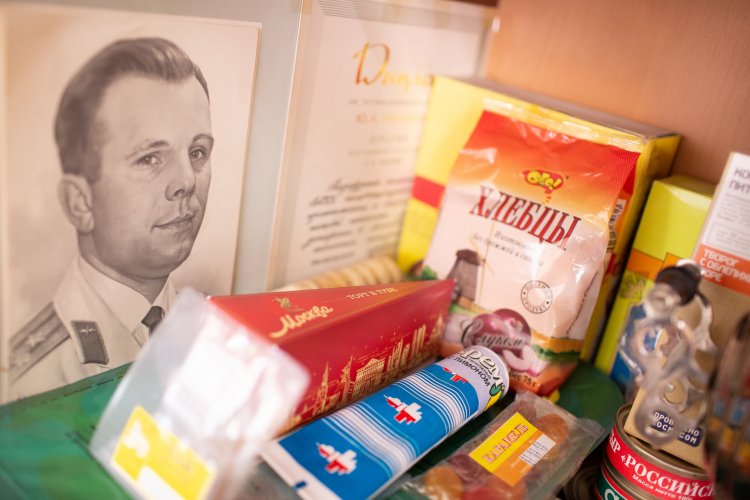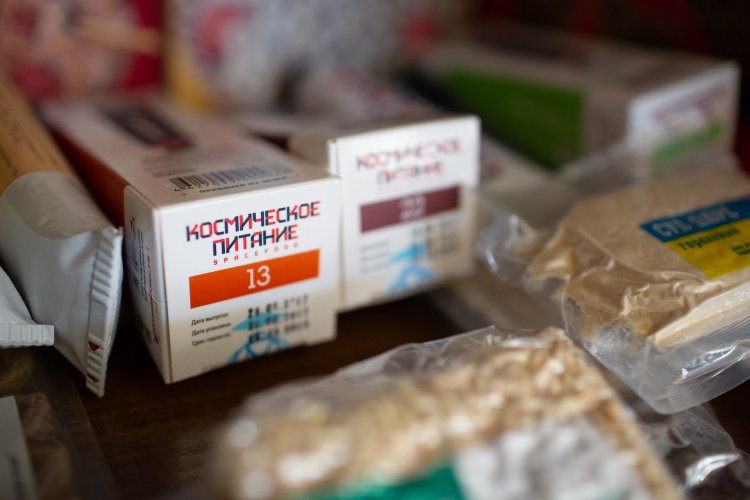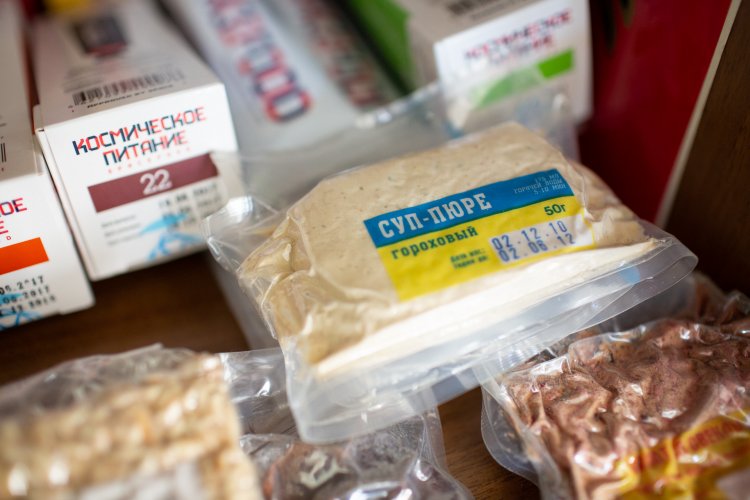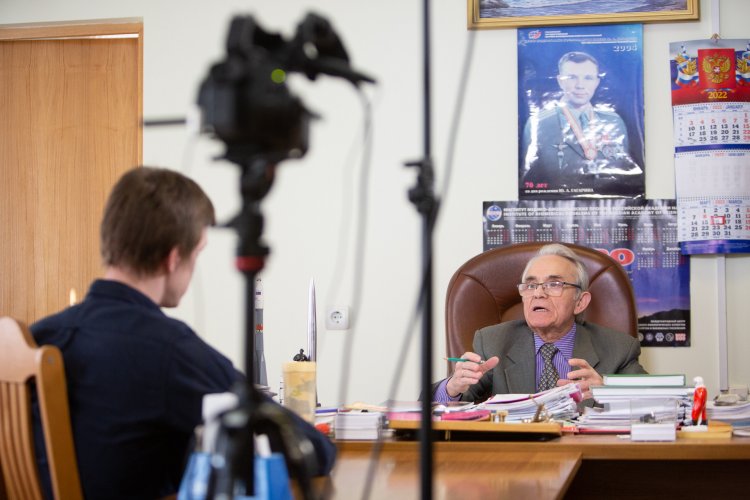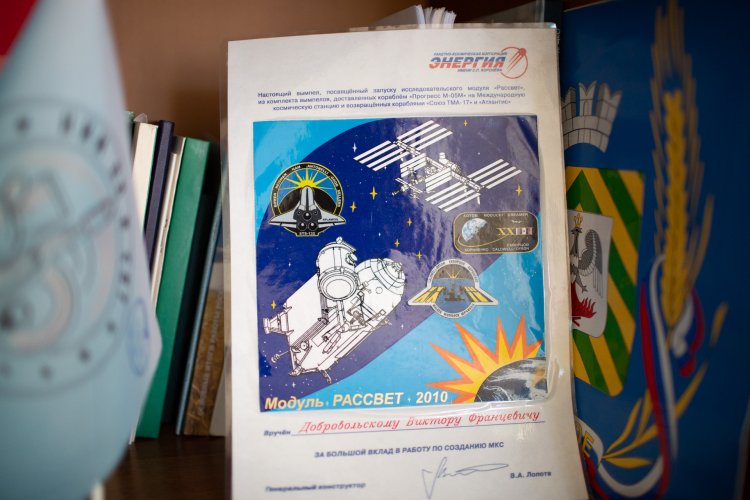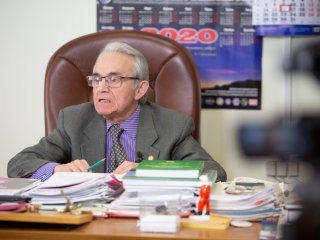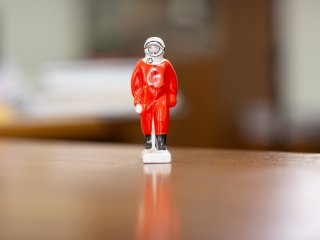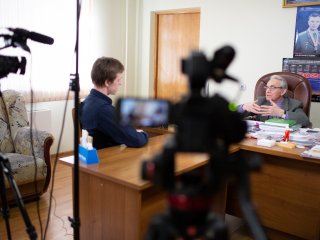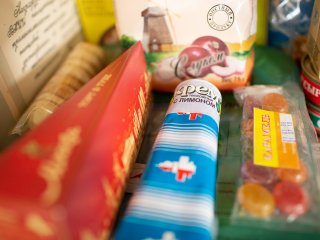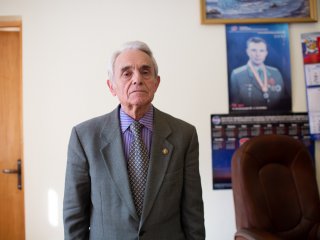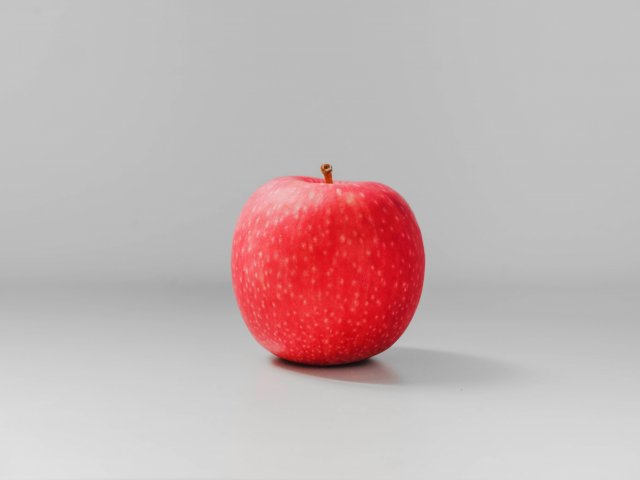What do astronauts eat? How have approaches to space diets and their production technologies changed over the past 60 years of manned flights? What kind of research is conducted to provide astronauts with food during future long-term missions?
To find out the answers – read Scientific Russia’s interview with Viktor Frantsevich Dobrovolsky, Doctor of Engineering, chief designer of space food.
Viktor Frantsevich Dobrovolsky, Doctor of Engineering, chief designer of space food
Photo: Andrey Luft, Scientific Russia
Russia celebrated the 60th anniversary of the first manned space flight in 2021. What kind of food were astronauts eating at the beginning of the space age, and what has changed in approaches to food menu since Yuri Gagarin’s flight?
When the question about astronauts’ food arose in the 1960s and 1970s, there was a shortage of information on the conditions of human beings’ stay in space and their state during flights. Therefore, the first research of space food were primarily based on data concerned with the conditions of high-altitude and long-range flights. The peculiarities of nutrition during space flights were also assessed based on the tests performed during model experiments.
The conditions of pilots and astronauts’ stay and life activity in small cabins led to a need to develop low-weight and small-sized food portions. The first assessments showed that pureed and liquid products might be the most acceptable option. We did not know at the beginning of this journey if people could swallow food in zero gravity at all, so the specialists of our institute started developing and producing paste-like and puree-like mashed food in 165g aluminum tubes.
The experience of the first flights via the Vostok and Voskhod spacecrafts helped determine a nutrition formula for astronauts that ensures the 1:1:3 ratio of nutrients, i.e. proteins, fats and carbohydrates. These data became a source point for developing food diets for the crews of the Soyuz transport spacecraft and the Salyut orbital station.
The stringent requirements to the food used during the first flights of the Soyuz transport spacecraft made food specialists start developing canned meat and food concentrates with a high content of solids.
The range of foods used in spacecrafts largely depended on spacecraft equipment: the installation of food heaters made it possible to heat canned food, including second courses, in jars and tubes. When an onboard system regenerating water from condensate appeared, they started including dehydrated second courses and beverages to be restored with water before consumption in the diet.
At that time, they developed three types of one-portion special bags: for first courses, second courses and beverages. Such a bag is filled with water through a special nozzle to restore food within 10-15 minutes. An astronaut drinks the first course right from the bag, no spoon is needed. The bag for the second course has a design that allows eating this food with a spoon. The beverage is also drunk right from the bag.
Canned food palls, while astronauts need diverse food being close to that eaten on the earth. Therefore, very quickly, the food industry began to develop freeze-dried products.
When did they start making freeze-dried food for astronauts?
They switched to freeze-dried food in the late 1970s – early 1980s. Now 60% of the food sent to astronauts is freeze-dried. This is actually the same food that we eat at home or at restaurants, it has the same consistency and nutrient profile.
When freeze-dried, the meal is first prepared in normal conditions – this may be both a first and a second course: garnishes, meat and fish dishes. The food is frozen in a special device, and then they create vacuum, so frozen ice leaves the product. Its cells are not destroyed, while health-giving elements do not leave the meal – freeze-dried food retains 90% of the nutrients.
For how long is freeze-dried food stored in space?
Today, freeze-drying allows storing ready-made meals for two years. However, if we talk about space exploration prospects, then the storage period should be increased to three years, and today we are working on this problem.
60% of all food items sent to orbit are freeze-dried. And what does the remaining 40% comprise?
Apart from freeze-dried food, we send canned food, beverages, dairy dishes, confectionery, as well as fresh vegetables and fruit. Back in the mid-1980s, USSR scientists developed a unique technology to keep fruit fresh for 30-40 days without any refrigerators. They are onions, garlic, apples, oranges, and grapefruits. Other countries still do not have such a technology – they send only canned fruit.
I may not tell you about the food processing technology itself – this is our know-how. I will only say that they use liquids to dip fruits into and then wrap them in special paper.
Photo: Andrey Luft, Scientific Russia
What does an astronauts’ diet comprise today and how is this menu selected?
An astronauts’ diet is based on meals – breakfast, lunch and dinner.
For breakfast, they eat canned meat or fish snacks served in small 100g jars, as well as juice, tea or coffee with confectionery.
For lunch, they necessarily eat a first course made of cereals, fresh or canned vegetables: beetroot soup, pickle soup, cream soup, pea soup. A second course is a canned meal in a 250g jar: meat with vegetable or cereal garnishes, fried dishes, omelets – whatever you like. As a dessert, they often eat freeze-dried farmer cheese with a topping – for example, currant, sea-buckthorn or cranberry puree. Astronauts like farmer cheese with nuts very much – they often order it from us.
For dinner, they again eat canned beef, pork, poultry, or fish snacks. They drink tea, coffee with confectionery, such as semi-dried fruit sticks.
Now we have developed over 300 food items for their menu. During the first flights, a menu was developed for one day, then for three, six, eight, twelve days. Today we have developed menus for sixteen days, which means that the main meals may repeat only in more than two weeks. Astronauts regularly consume juices, tea, coffee, confectionery, and bread. The food does not pall thanks to its wide choice, and we can offer diverse options.
Astronauts’ diet consists of two parts: main and supplementary. The main part is 2,000 kcal per day to be consumed by astronauts for medical reasons. This part of the menu comprises the amount of necessary proteins, fats and carbohydrates. The supplementary part includes meals with 1,000 kcal. Astronauts use it at will, for example, to recover after intense training, and can form it on their own by ordering supplies.
Sometimes astronauts’ taste preferences change – this process is very individual, as our taste buds work differently. Some astronauts feels the taste of food as if they are on the earth, while others sometimes consider salty food unsalted, and sweet food – not sweet.
What does space bread look like, what are its differences from our common bread?
This is our joint development with the Institute of the Baking Industry that produces space bread. These are small rectangular loaves – for one bite to avoid crumbs that may get into one’s respiratory tract. In normal conditions, this bread can be stored for up to one year.
What requirements should the food for astronauts meet?
The food should have the smallest possible weight and size while maintaining their biological value. Freeze-drying is right the technology to reduce the weight of food.
They should retain their original nutritional qualities and be safe even after long periods of storage at uncontrolled positive temperatures. Thus, this food must be stored at 20º to 30º, as there are no refrigerators on the ISS.
The ease of preparing and eating this food is also an important criterion. The food should contain a limited amount of liquid and should not crumble.
Food for astronauts is made of natural raw materials only. We do not use any synthetic additives, stabilizers or thickeners – only the highest-quality raw materials. Each supply is controlled by a special FMBA laboratory – there we send samples to be examined in chemical and biological parameters.
Therefore, astronauts’ food is an expensive product. One daily menu per astronaut cost about 35 to 40 thousand rubles: about 50% is the cost of raw materials and production, while the second half comprises quality and safety tests.
Photo: Andrey Luft, Scientific Russia
Have there been any emergencies concerned with astronauts’ nutrition over the 60-year history of space flights?
Never. There have been no cases of poisoning or stomach discomfort in this 60-year period.
Canned food for the space industry undergoes a special sterilization treatment. The traditional canned food can contain some part of conditionally pathogenic microbes, but they should be never present in space food. This is the purest product, so production workers are constantly checked. Let us hope that emergencies concerned with nutrition will never take place in the future.
Are food supplements included in astronauts’ diet?
No, food supplements are not used in space menus, all substances necessary for the body are contained in ready-made meals and food sets.
Astronauts are given one multivitamin pill a day, but this is a biologically active substance rather than a food supplement. Our factory is controlled by the Institute of Biomedical Problems of the Russian Academy of Sciences – their specialists make sure that the diet contains all necessary vitamins.
Probably, special food supplements will be developed for interplanetary flights, but we do not use anything of that kind now.
What food studies are focused on space exploration prospects?
Promising space food developments are associated with future long-term interplanetary flights: at first to the Moon, and then probably to Mars. Now freeze-dried food can be stored for two years and individual meals – for one year, but long-term space missions will require meals with a storage life of at least three years or even five years due to potential emergencies. We have not received a direct request from the customer yet, but we are discussing potential development routes at the moment.
We can increase the shelf-life of food products in normal conditions through the development of freeze-drying technologies. The spacecrafts that will be used for long-term missions should install space greenhouses for growing vitamins-containing greens. It is necessary to apply special methods to treat raw materials, such as irradiation and the like. For example, the Americans irradiate meat with strontium-90 and send steaks to their astronauts. Food irradiation is prohibited in our country now, but this issue will definitely arise in the future.
A separate issue is forming a menu for a long-term space flight. I defended my PhD thesis dedicated to space nutrition in 2000, and people were discussing space diets for long-term flights even at that time – the current menu is not be suitable for long-term flights.
We believe that a flight should be divided into main stages each of which having its own specific menu.
The beginning of a space mission is the time for adaptation – people get used to zero-gravity, limited space and their new neuropsychological state. This also applies to food – we should develop a special menu for the adaptation period having a duration that may depend on flight duration. However, this period will take at least one and a half or two months when it comes to flights to Mars.
An example of an adapted food menu from my thesis. First breakfast: omelet with chicken, rich wheat bread, apples with nuts, milk, vitamin dragees. Second breakfast: farmer cheese with sea-buckthorn puree, Russkoe cookies, Impulse beverage. Lunch: vegetable cream soup, beef a la homemade, Borodinsky bread, apricot sticks, apple juice, vitamin dragees. Dinner: chicken with prunes, rich wheat bread, fruit and berry dessert, relaxing beverage, dried apricots. These are the same meals that astronauts eat now, but they are included into different sets to take into account the necessary balance of nutrients at different flight stages.
Now astronauts go into outer space for six-seven hours. In the future, their spacewalks will probably reach 12-15 hours. It is important to make an astronaut’s meal to be eaten before leaving the spacecraft. My thesis proposes a set of such food. Besides, during a long spacewalk, the spacesuit should have food and beverages, so that astronauts do not have to starve for 12 hours.
Once astronauts adapt to the new conditions and their bodies get used to zero-gravity, they may consume food from the main diet – this is the menu that we are using now.
The last stage takes place before returning to the earth. Astronauts have to train a lot, so that their bodies can get used to new loads after coming out of zero-gravity, and therefore eat accordingly.
Each of these menus should take into account a separate balance of nutrients to be determined by specialists. Developing a diet at these stages means a significant job that has to be done.
Now the space food is the same as traditional meals eaten on the earth, but it is very high-quality and healthy, without exotic ingredients and seasonings. Besides, the Russian space food is the most health-giving and safest option in the world.

